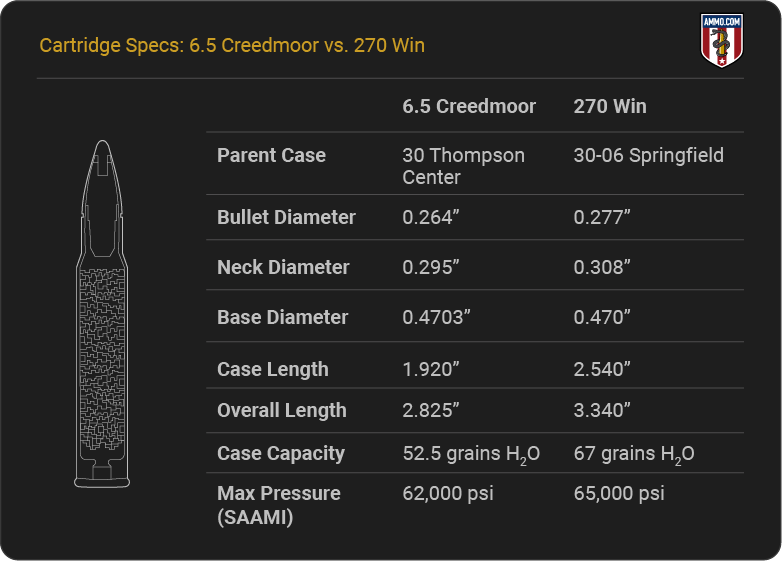In 2007, Hornady took the competitive long-range shooting community by storm with the release of the 6.5 Creedmoor. The cartridge has since grown into a household name (within households belonging to members of the shooting community, at least).
The 6.5 Creedmoor won plenty of praise on the competitive firing line immediately after its introduction. It only makes sense that shooters would also want to leverage the round’s famously flat trajectory and low recoil for hunting.
Now that it has become popular for taking large game, the 6.5 Creedmoor is often compared to one of the other great non-.30 caliber hunting cartridges: the 270 Winchester.
Does a competition round like the 6.5 Creedmoor offer any real advantages over the 270 Win, which has proved its worth in the woods time and time again for over a century? Let’s evaluate the 6.5 Creedmoor vs. 270 Win debate so you can understand the differences between the two rounds, and know which is better for your target shooting and/or big game hunting needs.
Cartridge Specs
When evaluating two cartridges, it’s good to gain more knowledge of each by analyzing their physical specifications.
The 270 Winchester (270 Win) received almost instant commercial success upon its release in 1925. The 270 was developed using the 30-06 as a parent case, which was necked down to accept a 0.277" (7mm, nominally) diameter bullet.
The 6.5 Creedmoor was released in 2007 and quickly became extremely popular in long-range competitive shooting circles. The 6.5 Creedmoor was developed following a gripe session between legendary Service Rifle competitor Dennis DeMille and Dave Emary, senior ballistician for Hornady at the time.
The 6.5 Creedmoor was developed by necking down a 30 Thompson Center case to accept a 0.264" (6.5mm, nominally) diameter bullet. It was conceived as a long-range target shooting round, but soon became popular among deer hunters for its accuracy, manageable recoil, and undeniably downrange stopping power.
The 6.5 Creedmoor is also called “6.5 CM” or “6.5 Creed.” The latter half of its name is often misspelled as “Creedmore.”
If you place these two rounds next to one another, their size difference becomes obvious at once. The 270 Win has an overall length of 3.34": more than 0.5" longer than the 6.5 CM’s 2.825". The 270’s case is also longer: 2.54", as opposed to 1.92" for the 6.5 CM.
Their difference in overall length means the 6.5 CM can fit into a short-action rifle, which is lighter and has a shorter bolt throw. In contrast, the larger 270 Win requires a long action just like the 30-06 Springfield it’s descended from.
Case capacity for the 270 measures 67 grains H₂O. For the 6.5 Creedmoor, it’s 52.5 grains H₂O. In other words, the 270 Win’s larger case has capacity for approximately 15% more powder than the 6.5 Creed. Both rounds have similar maximum pressures per SAAMI specs. The 270 is rated to handle chamber pressures up to 65,000 psi: 4.8% higher than the 6.5 CM at 62,000 psi.
The biggest difference between these rounds are the bullets they fire.
The 270 Win fires wider 0.277" diameter bullets. Bullet weights for the 270 range between 85 and 180 grains, with 130, 140, and 150 grain projectiles being most popular.
The 6.5 Creedmoor fires a 0.264" diameter bullet. Its bullets can weigh between 95 and 160 grains, with 120, 130, and 140 grain bullets being most common.
How do these differences in cartridge specification bear on real-world performance? Let’s find out, starting with recoil.
Continue reading 6.5 Creedmoor vs. 270 Win: From the Firing Line to the Tree Stand on Ammo.com
